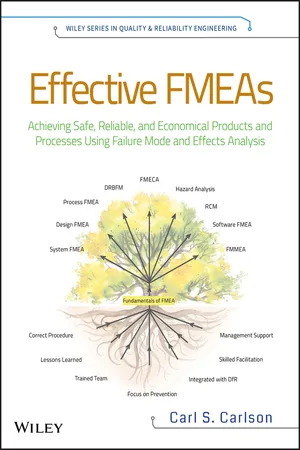
Effective FMEAs
Achieving Safe, Reliable, and Economical Products and Processes using Failure Mode and Effects Analysis
- English
- ePUB (mobile friendly)
- Available on iOS & Android
Effective FMEAs
Achieving Safe, Reliable, and Economical Products and Processes using Failure Mode and Effects Analysis
About this book
Outlines the correct procedures for doing FMEAs and how to successfully apply them in design, development, manufacturing, and service applications
There are a myriad of quality and reliability tools available to corporations worldwide, but the one that shows up consistently in company after company is Failure Mode and Effects Analysis (FMEA). Effective FMEAs takes the best practices from hundreds of companies and thousands of FMEA applications and presents streamlined procedures for veteran FMEA practitioners, novices, and everyone in between.
Written from an applications viewpoint—with many examples, detailed case studies, study problems, and tips included—the book covers the most common types of FMEAs, including System FMEAs, Design FMEAs, Process FMEAs, Maintenance FMEAs, Software FMEAs, and others. It also presents chapters on Fault Tree Analysis, Design Review Based on Failure Mode (DRBFM), Reliability-Centered Maintenance (RCM), Hazard Analysis, and FMECA (which adds criticality analysis to FMEA).
With extensive study problems and a companion Solutions Manual, this book is an ideal resource for academic curricula, as well as for applications in industry. In addition, Effective FMEAs covers:
-
The basics of FMEAs and risk assessment
-
How to apply key factors for effective FMEAs and prevent the most common errors
-
What is needed to provide excellent FMEA facilitation
-
Implementing a "best practice" FMEA process
Everyone wants to support the accomplishment of safe and trouble-free products and processes while generating happy and loyal customers. This book will show readers how to use FMEA to anticipate and prevent problems, reduce costs, shorten product development times, and achieve safe and highly reliable products and processes.
Frequently asked questions
- Essential is ideal for learners and professionals who enjoy exploring a wide range of subjects. Access the Essential Library with 800,000+ trusted titles and best-sellers across business, personal growth, and the humanities. Includes unlimited reading time and Standard Read Aloud voice.
- Complete: Perfect for advanced learners and researchers needing full, unrestricted access. Unlock 1.4M+ books across hundreds of subjects, including academic and specialized titles. The Complete Plan also includes advanced features like Premium Read Aloud and Research Assistant.
Please note we cannot support devices running on iOS 13 and Android 7 or earlier. Learn more about using the app.
Information
IN THIS CHAPTER
1.1 THE NEED FOR EFFECTIVE FMEAs
Microsoft said … it will take a $1 billion charge as it extends the warranty on the Xbox 360, after an investigation showed the game console can be prone to hardware failures.[1]
Name of Product: Lithium-Ion Batteries used in Hewlett-Packard, Toshiba and Dell Notebook Computers. Hazard: These lithium-ion batteries can overheat, posing a fire and burn hazard to consumers.[2]
Bridgestone Corp. … recalled 6.5 million of its Firestone-brand tires—the second largest tire recall in U.S. history—in response to complaints the tires may be linked to fatal crashes involving sport utility vehicles.[3]
Name of Product: 2009 Model Year FX10 Snowmobiles. Hazard: A bolt in the right front A arm can loosen in the suspension/steering system, resulting in the sudden loss of steering control. This poses a risk of injury or death to riders.[4]


1.2 FMEA APPLICATION BY INDUSTRY
Table of contents
- Cover
- Wiley Series in Quality & Reliability Engineering and Related Titles
- Title page
- Copyright page
- Dedication
- Series Editor’s Foreword
- Copyrights and Permissions
- Acknowledgments
- Introduction
- Chapter 1: The Case for Failure Mode and Effects Analysis
- Chapter 2: The Philosophy and Guiding Principles for Effective FMEAs
- Chapter 3: Understanding the Fundamental Definitions and Concepts of FMEAs
- Chapter 4: Selection and Timing of FMEA Projects
- Chapter 5: How to Perform an FMEA Project: Preparation
- Chapter 6: How to Perform an FMEA Project: Procedure
- Chapter 7: How to Develop and Execute Effective Risk Reduction Actions
- Chapter 8: Case Studies
- Chapter 9: Lessons Learned for Effective FMEAs
- Chapter 10: How to Facilitate Successful FMEA Projects
- Chapter 11: Implementing an Effective Company-Wide FMEA Process
- Chapter 12: Failure Mode Effects and Criticality Analysis (FMECA)
- Chapter 13: Introduction to Design Review Based on Failure Mode (DRBFM)
- Chapter 14: Introduction to Fault Tree Analysis (FTA)
- Chapter 15: Other FMEA Applications
- Chapter 16: Selecting the Right FMEA Software
- Appendices
- Index